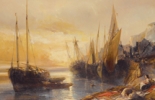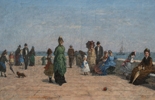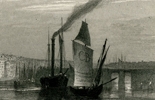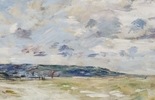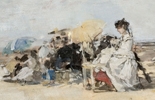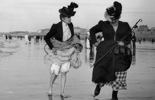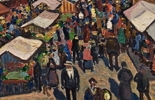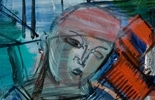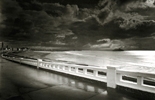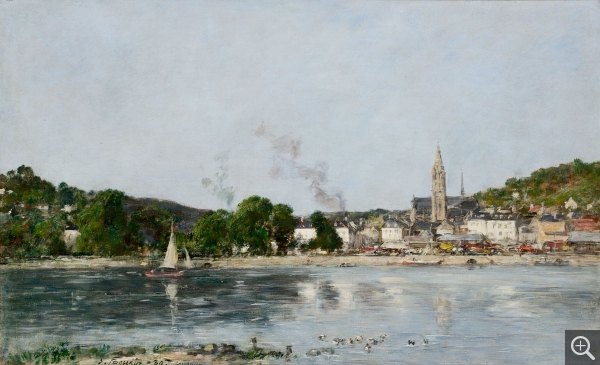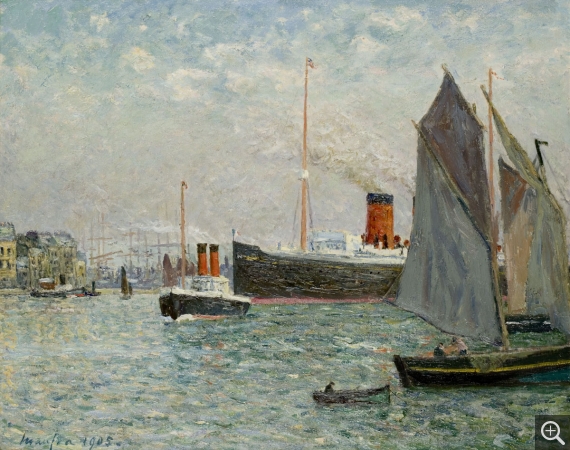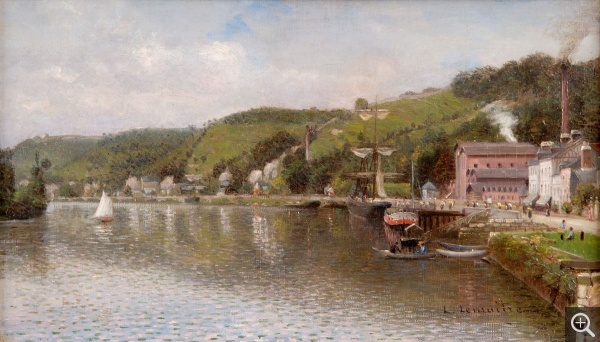L’estuaire de la Seine, l’invention d’un paysage
In addition to a nature that lavishes a variety of effects or a tamed nature, the Seine estuary provided proponents of the "nouvelle peinture”, or new painting, with subjects tied to modern life and urban activity. A major communication route between Paris and the Atlantic, the Seine in its lower course had an industrial and commercial component exemplified by its two major ports, Rouen and Le Havre. Many an artist came to explore their bustling quays. In this changing atmosphere of the inland and sea ports, the painters expertly rendered the variations in light, playing with the effects of natural mist and the clouds of fumes from the steamships that were starting to replace the tall sailing ships. In 1905, Maxime Maufra painted the first transatlantic liners with their massive red funnels, docked alongside the traditional fishing boats in the port of Le Havre.
Boudin was fascinated by the port motif and returned to it throughout his career. From the luminous, carefully crafted paintings of his early work to those by Lapostolet or Lépine, the landscapes gradually grew lighter in execution with freer brushstrokes, under the impetus of the Impressionists and particularly Monet, who painted his famous Impression, Sunrise in the port of Le Havre in 1873. But the Seine also provided a setting for other pictorial explorations with Neo-Impressionism, as seen in Banks of the Seine, Croisset by Lemaître, an advocate of the Rouen School, who rendered the water's surface vibrant with small touches of colour, but did not yet dare to push divisionism to the limit. Gradually brushstrokes grew bolder, broader, with stronger use of colour, heralding the next pictorial revolution: Fauvism.
Boudin was fascinated by the port motif and returned to it throughout his career. From the luminous, carefully crafted paintings of his early work to those by Lapostolet or Lépine, the landscapes gradually grew lighter in execution with freer brushstrokes, under the impetus of the Impressionists and particularly Monet, who painted his famous Impression, Sunrise in the port of Le Havre in 1873. But the Seine also provided a setting for other pictorial explorations with Neo-Impressionism, as seen in Banks of the Seine, Croisset by Lemaître, an advocate of the Rouen School, who rendered the water's surface vibrant with small touches of colour, but did not yet dare to push divisionism to the limit. Gradually brushstrokes grew bolder, broader, with stronger use of colour, heralding the next pictorial revolution: Fauvism.
- Eugène BOUDIN (1824-1898), The Seine, Caudebec en Caux, 1889, oil on canvas, 36 x 58 cm. © MuMa Le Havre / Florian Kleinefenn
- Maxime MAUFRA (1861-1918), Transatlantic Vessel Leaving the Harbour, 1905, oil on canvas, 65.5 x 81 cm. © MuMa Le Havre / Florian Kleinefenn
- Léon-Jules LEMAÎTRE (1850-1905), Banks of the Seine, Croisset, 1888, oil on canvas, 27 x 46 cm. Rouen, association des Amis de l’École de Rouen. © Dominique Langlois


